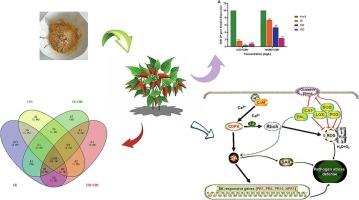Chitosan oligosaccharide regulates host defense in pepper plants against cucumber mosaic virus
IF 4
1区 农林科学
Q2 BIOCHEMISTRY & MOLECULAR BIOLOGY
引用次数: 0
Abstract
The pepper plant, a member of the Solanaceae family, is widely cultivated and valued as an important spice in many dishes worldwide. Viruses cause significant damage to both the quality and quantity of pepper production, with cucumber mosaic virus (CMV) being particularly detrimental. Chitosan oligosaccharide (COS), a natural oligosaccharide derived from chitosan degradation, act as a plant immunity inducer. The present study aimed to verify the role of COS in inducing CMV resistance in capsicum and to explore its potential defense-related signaling pathways. The optimal condition for inducing resistance to CMV is 100 mg/L of COS pretreatment on day 5 of CMV inoculation. COS enhances the removal of harmful free radicals by increasing the activity of antioxidant enzymes including peroxidase (POD), catalase (CAT), superoxide dismutase (SOD), and phenylalanine ammonia-lyase (PAL). Concurrently, COS treatment can increase the increases chlorophyll content. Additionally, COS upregulates the expression of defense-related genes (such as NPR1, PR1, PR5, PR10, CAT, POD, SOD, PAL, and LOX), which contribute to pepper resistance against CMV. Proteomic analysis revealed that COS induces resistance in capsicum by activating the calcium signaling pathway. Taken together, these data indicate that COS enhances capsicum's innate immunity against CMV through the salicylic acid pathway in combination with calcium signaling. This study sheds light on the effects of COS and its signaling mechanisms in plant viral immunity and offers a foundation for the discovery of novel antiviral agents and further mechanistic studies.

壳聚糖寡糖调控辣椒植株对黄瓜花叶病毒的防御作用
辣椒是茄科植物的一员,被广泛种植,在世界各地的许多菜肴中都被视为一种重要的香料。病毒对辣椒生产的质量和数量都造成重大损害,其中黄瓜花叶病毒(CMV)危害尤甚。壳聚糖低聚糖(COS)是由壳聚糖降解得到的天然低聚糖,具有植物免疫诱导剂的作用。本研究旨在验证COS在辣椒诱导CMV抗性中的作用,并探索其潜在的防御相关信号通路。诱导抗CMV的最佳条件是在CMV接种第5天用100 mg/L COS预处理。COS通过提高抗氧化酶(POD)、过氧化氢酶(CAT)、超氧化物歧化酶(SOD)和苯丙氨酸解氨酶(PAL)的活性来促进有害自由基的清除。同时,COS处理可以提高叶绿素含量。此外,COS还上调辣椒抗CMV的防御相关基因(如NPR1、PR1、PR5、PR10、CAT、POD、SOD、PAL和LOX)的表达,这些基因有助于辣椒抵抗CMV。蛋白质组学分析表明,COS通过激活钙信号通路诱导辣椒的抗性。综上所述,这些数据表明COS通过水杨酸途径与钙信号联合增强辣椒对CMV的先天免疫。该研究揭示了COS在植物病毒免疫中的作用及其信号机制,为发现新的抗病毒药物和进一步的机制研究奠定了基础。
本文章由计算机程序翻译,如有差异,请以英文原文为准。
求助全文
约1分钟内获得全文
求助全文
来源期刊
CiteScore
7.00
自引率
8.50%
发文量
238
审稿时长
4.2 months
期刊介绍:
Pesticide Biochemistry and Physiology publishes original scientific articles pertaining to the mode of action of plant protection agents such as insecticides, fungicides, herbicides, and similar compounds, including nonlethal pest control agents, biosynthesis of pheromones, hormones, and plant resistance agents. Manuscripts may include a biochemical, physiological, or molecular study for an understanding of comparative toxicology or selective toxicity of both target and nontarget organisms. Particular interest will be given to studies on the molecular biology of pest control, toxicology, and pesticide resistance.
Research Areas Emphasized Include the Biochemistry and Physiology of:
• Comparative toxicity
• Mode of action
• Pathophysiology
• Plant growth regulators
• Resistance
• Other effects of pesticides on both parasites and hosts.

 求助内容:
求助内容: 应助结果提醒方式:
应助结果提醒方式:


